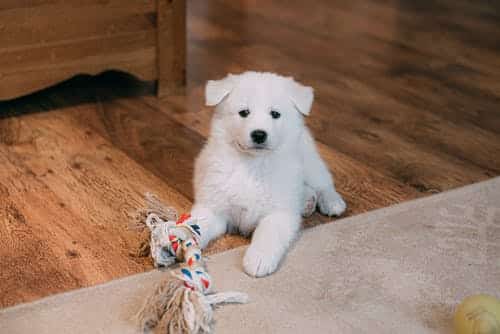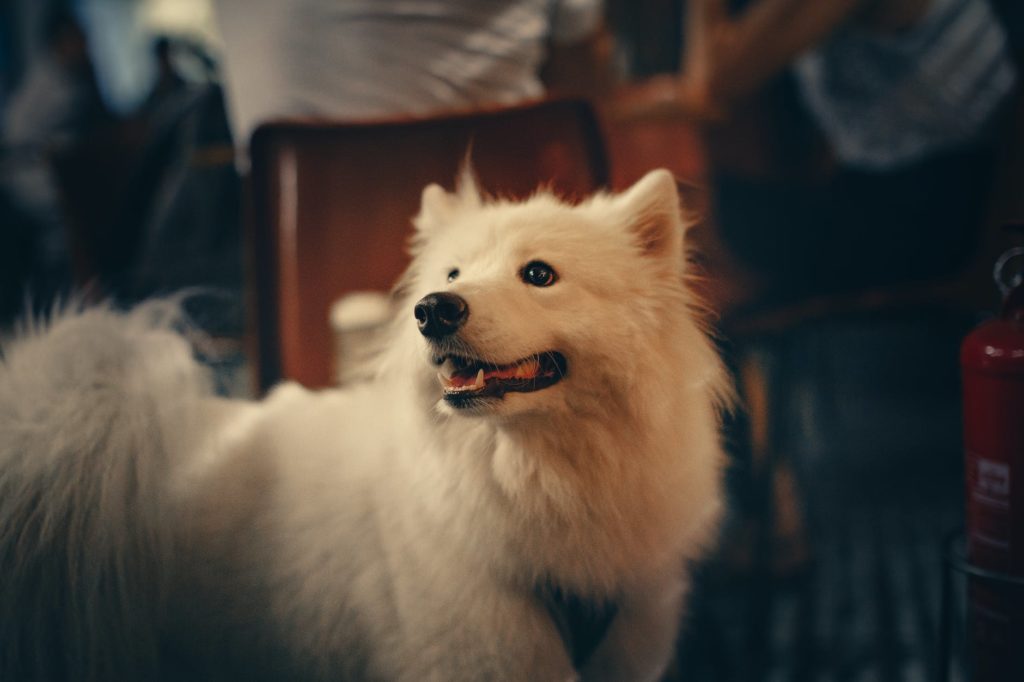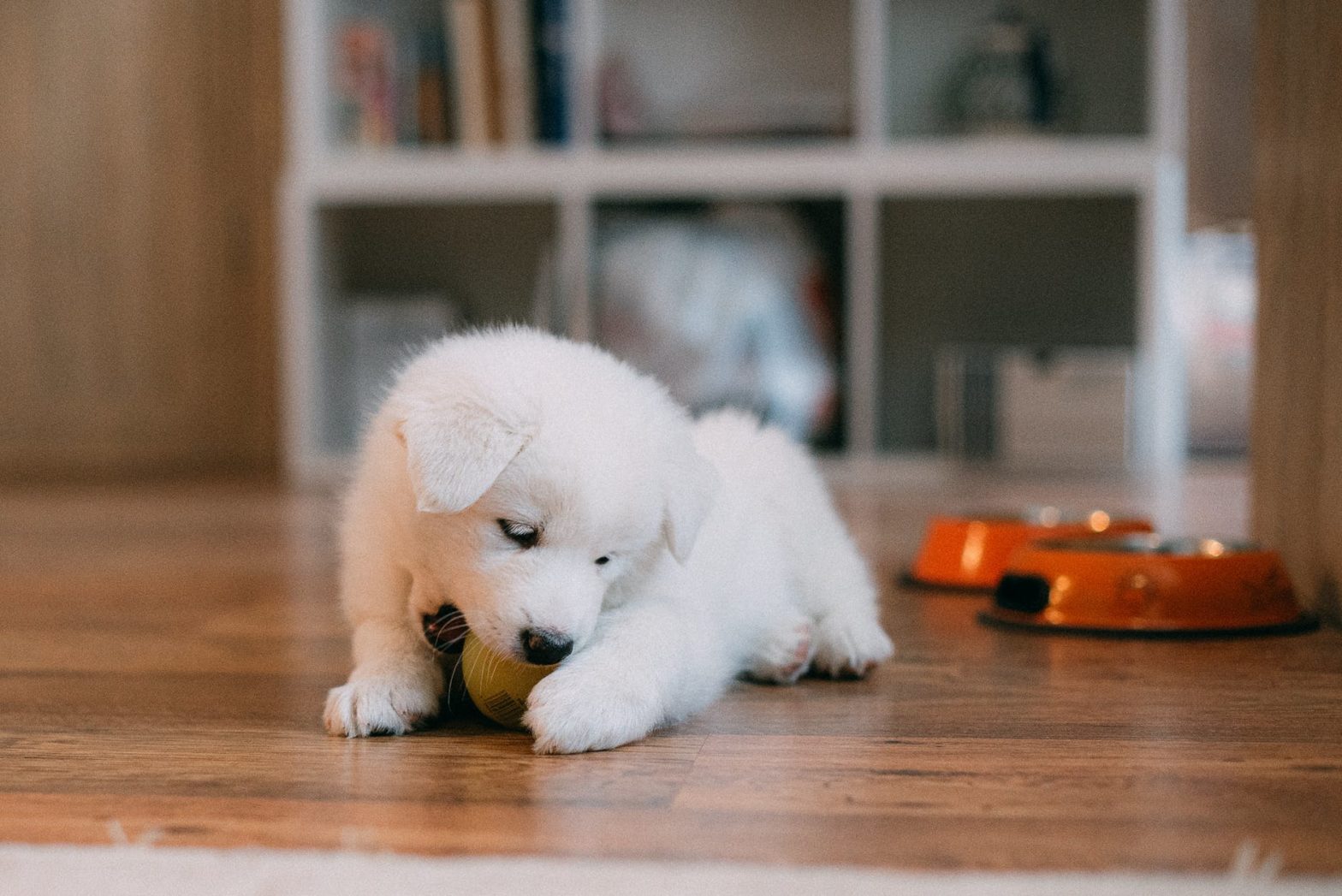Do you think that signature “Samoyed Smile” is more sinister than adorable? Do you believe that cute, white, loving, fluffy bundle of fur has a mean streak? Are Samoyeds aggressive? The short answer is no, Samoyeds are not aggressive dogs.
However, this doesn’t mean Samoyeds can’t develop some aggressive tendencies, especially if they are left alone for longer than four hours. These dogs love people! And if they aren’t getting enough attention at home, they might just take their frustrations out on your sofa.
Table of Contents
Their Upbringing

In the 19th Century, the Samoyed was bred to pull sleds, hunt, and herd livestock for Siberia’s Samoyede people. Their calm demeanor made them better herders than hunters. Other duties included hiking, tracking, and even sleeping on top of their owners to keep them warm at night!
This is how the Samoyed formed their deep bond with humans. They’re a working breed, who love exercise and make great family pets. Samoyeds will often find one member of a family to form a bond with. They will listen to that family member the most. This is because back in Siberia Samoyeds worked in packs led by “Alpha Dogs.”
The Samoyed will look at the family as a pack and identify the “Alpha” to obey. When Samoyeds don’t receive love or attention from the alpha or other family members, they tend to get aggressive.
Lonely Samoyeds Are Aggressive Samoyeds
Leaving your Samoyed alone for hours on end can spark some aggressive behavior. They are not acting out of anger, and they will not attack your family members or other people.
Lonely Samoyeds are simply bored! They thrive in the presence of others and they don’t know what to do with themselves when no one is hanging out with them. Historically, Samoyeds were never alone and they were always given tasks to accomplish. Keeping your Samoyed preoccupied with exercise or affection will prevent it from developing aggressive tendencies.
Aggressive Samoyeds Need Exercise
Samoyeds love a good game of fetch! And if you need a little bit of extra mustard on your throws try using a ball chucker from Chukit!
- THROW FARTHER AND FASTER: Enhance your fetch game with the Chuck It Ball Launcher; designed to increase your throwing speed and distance for a more challenging playtime
- NO MORE SLOBBERY BALLS: Keep your hands clean with the ball thrower for dogs; featuring a design that extends your reach for easy ball pickup without bending over or touching slobbery surfaces
- FOR MEDIUM DOGS: Specifically crafted for dogs weighing 20-60 lbs, this tennis ball thrower for dogs fits 2.5" diameter tennis balls or medium Chuckit balls; it's the ideal size for optimal play sessions
- BRIGHT AND HIGHLY VISIBLE: Includes a brightly-colored, high-bounce Chuck It Ball, easy to spot for engaging pets and owners
- DURABLE AND EASY TO USE: The Classic dog ball thrower has been successful for over 20 years
Samoyeds need at least an hour of daily exercise to tire them out. Really energetic Samoyeds may even need up to two hours of exercise…or maybe more. The more exercise a Samoyed gets, the more comfortable it will be alone. A few rounds of cardio (i.e jogs around the block) will quickly tire out your Samoyed.
A tired Samoyed won’t get up to much mischief as it will spend most of its time resting. It’s a good idea to take out your Samoyed just before you head off to run errands or go to work.
What Kind Of Aggressive Mischief Will Samoyeds Get Up To?

Let’s say you woke up late for work. You shower quickly and throw down some coffee and toast while rushing out the door to catch the train. You forgot all about your poor Samoyed, Sylvester.
Good ol’ Sly really wanted to go for a walk and maybe mix in a few rounds of fetch with you before seeing you off for work. He was really craving some one on one bonding time with his alpha.
Now Sylvester is at home, alone. This makes Sylvester bored and irritated. He sits in his doggy bed, trying to catch some shut-eye, but he’s too wound up to rest.
He sits at the door for a few minutes thinking maybe you’ve only run off to the store, and you’ll be back soon. It’s been ten minutes, and you’re not back yet. This irritates Sylvester and now he starts barking, and doesn’t stop.
When he realizes the barking isn’t going to bring you back, he gets even more infuriated! Now he’s finding ways to exercise himself.
Sylvester speeds up and down your staircase over and over. He loves his cardio. Then he heads over to your sofa. He always thought those plush pillows would make excellent chew toys. He heads over to your shoes and gives them some love too.
All these extracurriculars make Sylvester thirsty so he gulps down a bowl of water. He wanders back to the door and delivers an encore of his barking routine for the neighbors. You’re still not back.
Now nature is calling Sylvester. He doesn’t want to answer, he’s trying not to answer, but nature is not hanging up. He eventually relieves himself on your Venetian rug.
By the way, you can spare all the rugs in your home from Sylvester’s wrath with a highly absorbent “pee pad.” They’re washable, reusable, and comfortable.
No products found.
Dramatic, But Not Far-Fetched
This is a dramatic example of the aggressive tendencies a Samoyed can get up to when you’re not around.
Normally a house-trained and exercised Samoyed will be comfortable with you being gone for a few hours, but puppies and young Samoyeds have no idea when you’ll return. This makes them antsy. It helps to leave some toys around the house in hopes that your Samoyed will target them first before heading towards your cushions. A few plush toys resembling cushions should do the trick.
It’s a good practice, no matter how much of a rush you’re in, to take your Samoyed out to do its business and try your best to give it some exercise. The interior of your home and your neighbors will thank you. Think about how you would feel if you couldn’t use the washroom for eight hours at the office. Things would certainly get messy. A Samoyed with a bladder less than half the size of yours can’t be expected to wait around all day without using the facilities.
As you can see, any aggressive tendencies will be directed towards objects rather than people. This makes Samoyeds excellent watchdogs and lackluster guard dogs.
What Is A Watch Dog & How Does It Differ From A Guard Dog?
As mentioned the Samoyed doesn’t have a true hunting instinct. Samoyeds were great livestock herders and could warn the Samoyede people of incoming trouble.
That herding mentality is still a part of the Samoyed breed. This makes them great watchdogs. Sometimes you’ll see your Samoyed jump on its back legs or start barking during your daily walks.
When this happens, your Sammy is trying to warn you of potential danger. Now, it’s usually something minor, like a squirrel. But a Samoyed will have your back no matter the size of the threat.
Samoyeds will warn you of danger, but they will not take action against it. They leave the decision making up to you.
Whereas a guard dog will identify the threat and take action against it on your behalf. Samoyeds do not have a naturally aggressive temperament, so they will not attack potential threats.
Their watchdog duties don’t end with you. They carry forward to the rest of your family and your belongings. Anything you value, your Samoyed will also value. Unless your Samoyed is left at home for hours on end, then those sofa cushions you value will be chewed to bits. They also defend their own property. If any animal, dog, or person comes near their territory they will take on an aggressive stance and start barking.
Different Forms Of Aggression

Don’t mistake a Samoyed’s playful behavior for aggression. When a Samoyed is in the park with other dogs it may jump or nip for fun. This is typical dog behavior.
When your Samoyed jumps on other people they are only trying to play, although some might interpret it as rude and aggressive. If your Samoyed makes a habit of jumping on people, you’ll need to train them out of it.
There are different forms of aggression that you might see your Samoyed display depending on the situation.
Pain Aggression
If your Samoyed is in pain due to an unknown injury, it might behave aggressively when you approach the source of the issue. For example, one day you notice your Samoyed limping. When you reach for it’s leg to examine, your Sammy begins to snarl, growl, and even try to bite you. This behavior would be aggressive and out of the ordinary for most Samoyeds. However, this reaction is not unique to Samoyeds. Other dog breeds react in a similar fashion when they are injured.
Redirected Aggression
When your Samoyed detects a threat and feels like you are trapped, it may decide to defend both of you.
What can happen is that if you are holding it back from attacking, it may bite you to let it free. This is not because the dog intends to be aggressive towards you. It simply wants to defend you at all costs, even if it causes you slight harm in the process.
You are the key powering that signature “Samoyed Smile.” Everything a Samoyed needs for a happy life revolves around you. That’s why it will defend you at any cost.
Intraspecies Aggression
This is aggression shown towards other dogs. This usually happens when play becomes personal.
It can be a sign that your Samoyed is not socialized to interact with other dogs. Or if your Samoyed is a rescue, it may have a history of abusive interactions with other four-legged friends and has been conditioned to this response. This is yet another form of aggression you’ll have to train out of your Samoyed if you witness this behaviour at the dog park.
Fear Aggression
When a Samoyed is nervous and afraid it can become aggressive. This doesn’t mean the Samoyed will start biting or attacking.
Their behavior ranges from barking or taking an aggressive stance. The goal is to help calm your Samoyed’s fears in these situations. Samoyeds are high energy dogs. They’re hyperactive to say the least. To keep a fearful Samoyed calm, continuous daily exercise is required. The more you tire out a Samoyed, the less fearful it will be. While the dog matures physically a year after birth, it remains a mental puppy for most of its life. And puppies, are very energetic.
It Comes Down To The Alpha
Samoyeds are fun-loving family dogs who adore the company of people. If you or your family give them enough attention, love, and exercise they will be in a state of bliss.
Samoyeds are a good breed for stay at home families or individuals who work from home and don’t travel. This gives the Samoyed someone to always be with.
Train your Samoyed to live life in complete harmony with each other, and to ensure you don’t always have to be at its side.
From the start of your ownership, you need to establish a dominance hierarchy to show your Samoyed that you are alpha.
Untrained Samoyeds can be a danger to themselves on walks because they are hyperactive and will chase anything in sight. After establishing dominance you can then layout rules for obedience.
Teach your Samoyed basic orders; “come,” “no,” “sit,” and “stay” are a good start. This will keep them calm on your walks.
If you want more information on training your Samoyed and other tips for success, we recommend looking into a Samoyed training book, such as the Samoyed Dog Complete Owners Manual.
- Hoppendale, Geroge (Author)
- English (Publication Language)
- 184 Pages - 11/08/2015 (Publication Date) - IMB Publishing samoyed dog (Publisher)
Early Training For Aggressive Samoyeds
If you’ve adopted a Samoyed puppy or purchased one from a breeder you should both enroll in a puppy socialization/kindergarten class where dogs and owners are taught to build working relationships with each other. This teaches Samoyed how to interact with other dogs and people.
Obedience classes are another good investment for a new Samoyed. They are a breed that is eager to please and will generally do anything you ask them too, as long as it makes you happy. This means that harsh training methods are not required for Samoyeds. They should be very comfortable adapting to the mentioned voice commands.
Samoyeds are vocal dogs. Barking is their number one method of communication. This is due to their high level of intelligence. Because of this, they need to learn the “Quiet” or “Settle” command. The last thing you want is a barking mad Samoyed on your hands.
Breeders and vets can point you in the direction of good obedience instructors. Have them teach you the methods as well so you can implement them at home with your Samoyed.
As long as you or your family dedicate enough time to a Samoyed after it is trained, expect to see minimal to no aggressive behavior. Some may be worried about Samoyeds around kids, but the two often have great relationships. Samoyeds understand that children make their owners happy. And since they are people lovers, Samoyeds tend to be very protective of the young.
In Conclusion…
Samoyeds are more work than most breeds, but aggression is not their forte. Keep your Sammy exercised and preoccupied and it will be smooth sailing. Just remember, that Samoyed Smile will always be there for you.


